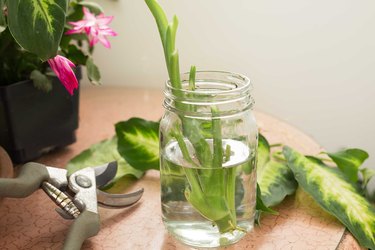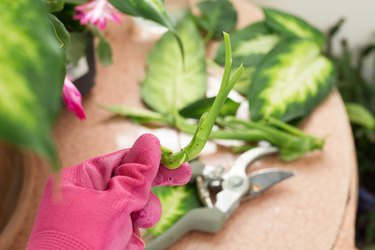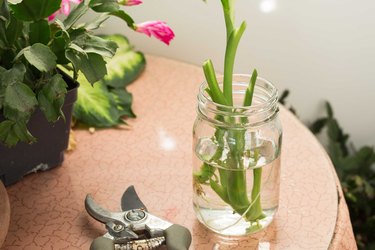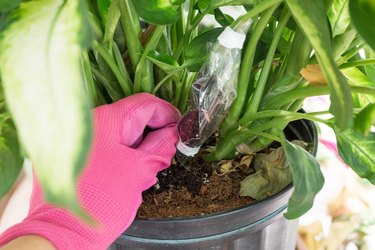
Dieffenbachia (Dieffenbachia seguine, formerly Dieffenbachia maculata and Dieffenbachia picta) is an enduring houseplant, with a perennial range in U.S. Department of Agriculture plant hardiness zones 10 through 12. It's a snap to root new plants using any one of the three propagating methods.
Rooting in Potting Medium
Video of the Day

Before taking stem cuttings, sterilize the pruning tool by soaking it for five minutes in a solution of 3 parts water and 1 part household pine-oil cleaner and rinse the pruner with water. Although the stem tips typically root faster than lower stem sections, you can also root cuttings from the middle or the base of a plant. Cut the canelike stem into sections that have one or two nodes each, usually 2 to 3 inches long, and remove any leaves, marking which end is up. You can take only a few cuttings from part of a stem or prune an entire stem to the base and section it into cuttings. Set the cuttings out of direct sun to dry overnight. Prepare a rooting medium that optimally contains 50 percent sphagnum peat moss, 25 percent composted pine bark and 25 percent perlite, place it in a shallow container, and moisten it thoroughly.
Video of the Day
Insert the cuttings in the potting mix to half their height, making sure the buds are facing upward and the marked end is up. Optionally, you can lay the cane sections horizontally on the soil so that half their diameter is buried. Keep the potting mix moist and warm with a minimum temperature of 75 degrees Fahrenheit for best results. The cuttings typically root in 3 to 8 weeks. Although dieffenbachia stems root easily without additional treatment, you can dip the base of the cuttings in rooting hormone powder or liquid before pressing the canes into the soil to promote new roots. Transplant each cane section into a 3-inch pot containing peat moss or a well-draining peat-based potting mix when the canes grow shoots and roots.
Rooting in Water

To root dieffenbachia in water, cut stem sections that are 4 to 6 inches long and remove all the leaves. Place the cuttings in a glass of water, and change the water as often as needed to keep it clean. Keep the jar in a warm, brightly lit area out of direct sunlight. Transplant each cutting into a 3-inch pot filed with a well-draining, peat-based potting mix when only a few roots form. If you let the cuttings form long roots in water, the stems may be more difficult to transplant successfully.
Air Layering

If a dieffenbachia loses many of its lower leaves and becomes leggy, or if you want to propagate a larger plant than taking stem cuttings produces, air layering is the answer. Slice a section of stem, making a 2-inch upward cut into the center of the stem. Keep the cut open by inserting some moist sphagnum peat moss or a toothpick that you twirl in rooting hormone. Place a handful of damp sphagnum peat moss in the center of a square of plastic kitchen wrap, and secure the moss around the stem by wrapping the plastic around it. Soak the moss in water for several hours, and hand-squeeze the excess moisture so that it is moist but not dripping before applying to the plant. Seal the plastic around the top and bottom by using electrician's tape around the stem, and keep the wrapped stem out of direct sunlight. When new roots grow through the moss and become visible through the plastic wrap, cut the stem below the roots, remove the plastic wrap leaving the moss intact and transplant the new plant into a container with potting mix. Insert two dowel rods or bamboo stakes into the pot, over which you place a loose, clear plastic bag as a humidity tent. Leave the tent in place out of direct sun for a week to 10 days to facilitate transplanting and encourage the roots to grow.
Propagating Precaution

Dieffenbachia's common name -- dumb cane -- serves as a reminder to wear gloves and protective clothing when working with this plant. Not only can it give you itchy skin, its toxic sap can cause swelling, burning or numbing of the mouth and possibly vocal chord paralysis. Corneal damage may result if you touch your eyes after handling the plant. This is a plant to keep out of the reach of curious children and pets.